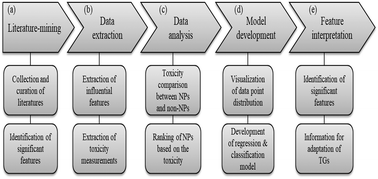Meta-analysis of Daphnia magna nanotoxicity experiments in accordance with test guidelines†
Abstract
Ecotoxicological assays have examined the risk of nanoparticles (NPs) to Daphnia magna (D. magna). However, significant inconsistencies in assay results have been found among studies conducted according to D. magna test guidelines (TGs) issued from the OECD (Organization for Economic Co-operation and Development) and US EPA (United States Environmental Protection Agency). Moreover, the inconsistencies have not yet been explained as a diverse range of factors may cause heterogeneity in the assay results. Here, a meta-analysis was performed to identify the causes of these inconsistencies. Data from experimental studies were collected when they were in accordance with TGs. A dataset was compiled by extracting the physicochemical properties of NPs, the experimental conditions of the assays, and the measured toxicities to D. magna. In total, 882 data points (NPs per set of experimental conditions) were obtained from 83 publications. Meta-analyses revealed that the toxicity of NPs was higher than that of non-NPs (TEM diameter >200 nm), and the toxicity of non-coated NPs did not correlate with the TEM diameter of NPs. In addition, the dataset was divided into four classes according to the state of the NPs, including metal oxide, metal, coated metal, and carbon nanomaterials, and a prediction model was developed for each class using a support vector machine to identify the features that influenced toxicity. Dispersion methods were identified as the most important experimental conditions that explained inconsistencies in results as they explained the most variation in the model. Therefore, dispersion methods for NPs may need to be adjusted in the TGs to reduce the heterogeneity in toxicity assay results for NPs.



 Please wait while we load your content...
Please wait while we load your content...